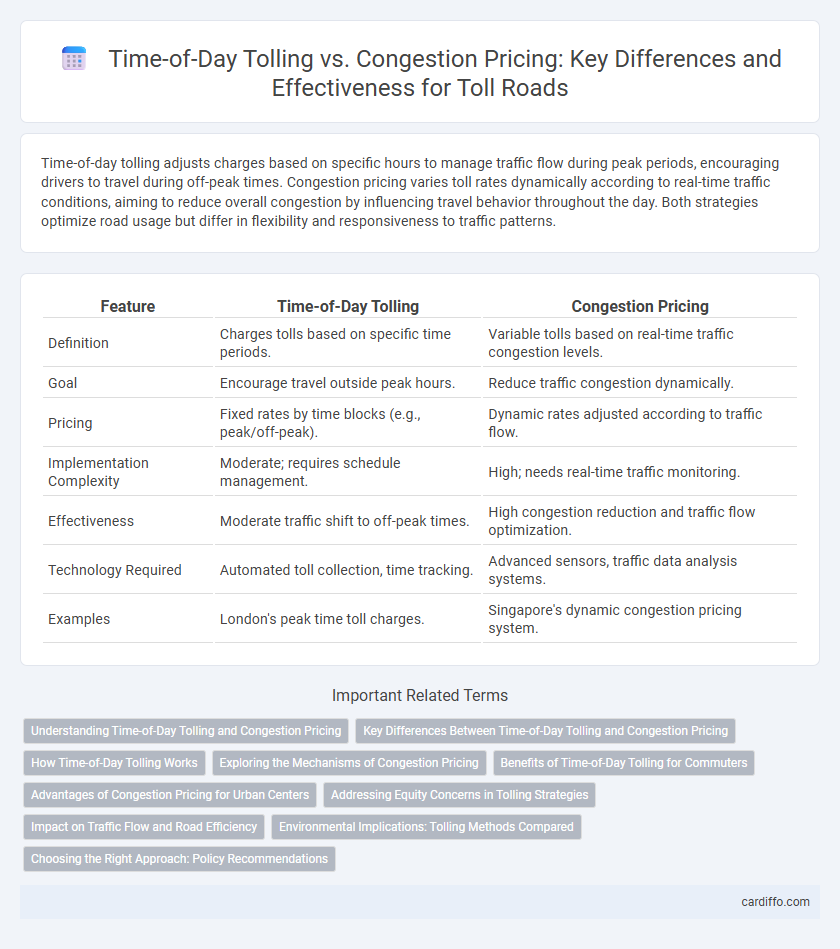Time-of-day tolling adjusts charges based on specific hours to manage traffic flow during peak periods, encouraging drivers to travel during off-peak times. Congestion pricing varies toll rates dynamically according to real-time traffic conditions, aiming to reduce overall congestion by influencing travel behavior throughout the day. Both strategies optimize road usage but differ in flexibility and responsiveness to traffic patterns.
Table of Comparison
| Feature | Time-of-Day Tolling | Congestion Pricing |
|---|---|---|
| Definition | Charges tolls based on specific time periods. | Variable tolls based on real-time traffic congestion levels. |
| Goal | Encourage travel outside peak hours. | Reduce traffic congestion dynamically. |
| Pricing | Fixed rates by time blocks (e.g., peak/off-peak). | Dynamic rates adjusted according to traffic flow. |
| Implementation Complexity | Moderate; requires schedule management. | High; needs real-time traffic monitoring. |
| Effectiveness | Moderate traffic shift to off-peak times. | High congestion reduction and traffic flow optimization. |
| Technology Required | Automated toll collection, time tracking. | Advanced sensors, traffic data analysis systems. |
| Examples | London's peak time toll charges. | Singapore's dynamic congestion pricing system. |
Understanding Time-of-Day Tolling and Congestion Pricing
Time-of-day tolling adjusts road usage fees based on specific periods, targeting peak travel hours to manage demand and reduce traffic congestion. Congestion pricing applies dynamic charges that vary with real-time traffic density, incentivizing drivers to avoid crowded routes or travel times. Both strategies aim to optimize roadway efficiency by influencing driver behavior through variable pricing models linked to traffic patterns.
Key Differences Between Time-of-Day Tolling and Congestion Pricing
Time-of-day tolling charges drivers different rates based on specific periods, typically higher during peak hours, to manage demand and encourage travel outside congested times. Congestion pricing adjusts tolls dynamically in real-time according to traffic conditions, aiming to reduce overall congestion by reflecting current roadway demand. While time-of-day tolling uses fixed schedules for pricing, congestion pricing relies on continuous monitoring and variable charges to optimize traffic flow.
How Time-of-Day Tolling Works
Time-of-day tolling varies road usage fees based on specific time periods to manage traffic flow and reduce congestion during peak hours. This system charges higher toll rates during morning and evening rush hours, encouraging drivers to travel during off-peak times or use alternative routes. By adjusting toll prices dynamically, time-of-day tolling optimizes road capacity and minimizes delays on congested highways.
Exploring the Mechanisms of Congestion Pricing
Congestion pricing uses dynamic toll rates that adjust based on real-time traffic conditions to reduce peak-hour congestion and promote efficient road usage, differing from static time-of-day tolling that applies fixed charges during predetermined periods. This mechanism encourages drivers to alter travel times, routes, or modes of transportation, effectively managing demand on congested roadways. By leveraging data from traffic sensors and GPS, congestion pricing systems optimize toll rates to balance traffic flow and minimize delays.
Benefits of Time-of-Day Tolling for Commuters
Time-of-day tolling effectively reduces peak-hour traffic congestion by encouraging drivers to travel during off-peak periods, leading to shorter commute times. This pricing strategy improves overall roadway efficiency and reliability, helping commuters save time and reduce fuel consumption. Additionally, it promotes equitable travel choices by providing lower toll rates during non-peak hours, making transportation more affordable for a broader range of drivers.
Advantages of Congestion Pricing for Urban Centers
Congestion pricing in urban centers effectively reduces traffic volume during peak hours by charging drivers higher fees, thereby decreasing air pollution and promoting public transportation usage. This dynamic pricing model generates significant revenue that can be reinvested into infrastructure improvements and sustainable mobility projects. Unlike static time-of-day tolling, congestion pricing adapts to real-time traffic conditions, ensuring optimized traffic flow and reduced travel times.
Addressing Equity Concerns in Tolling Strategies
Time-of-day tolling adjusts fees based on peak and off-peak hours to manage traffic flow, often leading to more predictable and affordable access during non-peak times. Congestion pricing dynamically varies charges according to real-time traffic conditions, effectively reducing congestion but potentially imposing higher costs on lower-income drivers who travel during peak periods. Addressing equity concerns requires implementing targeted subsidies, income-based discounts, or reinvesting toll revenues into public transit enhancements to ensure fair and inclusive access for all socioeconomic groups.
Impact on Traffic Flow and Road Efficiency
Time-of-day tolling adjusts fees based on predetermined peak and off-peak periods, which can smooth traffic flow by encouraging drivers to travel during less congested times. Congestion pricing dynamically varies charges in real-time according to current traffic density, directly reducing road congestion and improving overall road efficiency. Studies show congestion pricing leads to more significant decreases in peak-hour traffic delays and increases average travel speeds compared to static time-of-day tolling.
Environmental Implications: Tolling Methods Compared
Time-of-day tolling reduces emissions by encouraging drivers to travel during off-peak hours, decreasing congestion during high-demand periods. Congestion pricing directly targets traffic volume by charging higher rates in heavily congested zones, leading to more significant reductions in vehicle idling and air pollution. Both methods improve air quality, but congestion pricing typically yields greater environmental benefits due to its dynamic pricing structure aligned with real-time traffic conditions.
Choosing the Right Approach: Policy Recommendations
Time-of-day tolling effectively manages peak traffic by varying rates according to specific time intervals, reducing congestion during high-demand periods. Congestion pricing dynamically adjusts tolls based on real-time traffic conditions, providing stronger incentives for drivers to alter travel behavior when roads are most crowded. Policymakers should evaluate urban traffic patterns, technological infrastructure, and public acceptance to select an approach that maximizes congestion reduction while ensuring equitable access and revenue stability.
Time-of-day tolling vs congestion pricing Infographic

 cardiffo.com
cardiffo.com